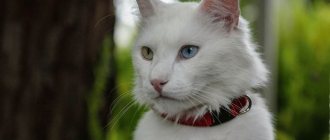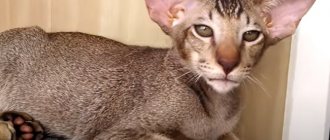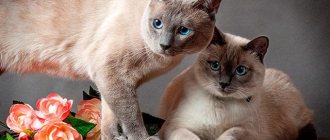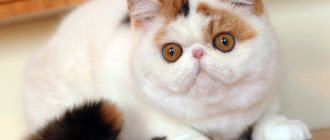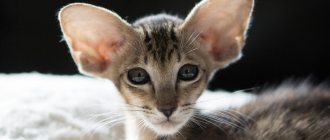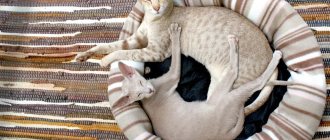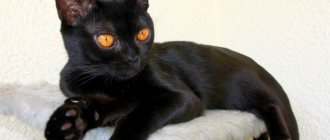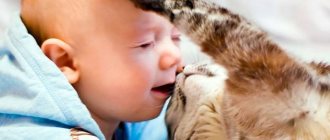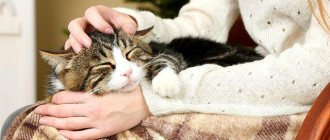Oriental cats, or oriental cats, are a breed that officially appeared relatively recently. Representatives of this breed are distinguished by their unusual appearance, graceful movements, and good-natured disposition. They absolutely do not tolerate loneliness, therefore, if you get them, then only with the confidence that the cat will receive a sufficient amount of attention and care.
Oriental cats, or oriental cat, are a breed that officially appeared relatively recently
Oriental cats immediately attract the eye with their unusual appearance. They look like fairy-tale animals that seem to have come from ancient times. Some say that it was the Oriental Siamese cats that were revered in Ancient Egypt. Perhaps this is why representatives of this breed look so elegant, and their gaze is truly magical and even hypnotic.
Description of the Oriental cat breed
Popularity 48th place among 86 cat breeds
Lifespan:
15-20 years
Height:
23-25 cm
Country of origin:
USA, UK, Thailand
Average price:
30-45 thousand rubles
Weight:
3-8 kg
Latest articles Cat care
How to trim a cat's claws correctly and easily 01/28/2022 139 0 0
Dog health
How to do an ultrasound for dogs: preparation and procedure 01/28/2022 63 0 0
How to choose an Oriental kitten
The peculiarity of the Oriental cat is the harmonious combination of powerful strength and refined grace. These animals have beautiful body proportions and often participate in exhibitions. Oriental cats quickly adapt to their home environment and show sincere love for humans.
Before choosing a small kitten, you should decide on its color, as it is very diverse. Also, an Oriental cat must be 3 months old or older, since immunity is developed during the period of feeding with mother’s milk. To acquire a healthy animal, it must not be separated from its mother early. Also, the Oriental cat must have medical records of the mother, father, vaccination record and titles.
In appearance, the kitten should be active and healthy. His coat should be smooth and shiny. It is important that the cat’s eyes are shiny and lively, and that there is no squinting. There can be no crusts on his nose. The kitten must meet the standards that are typical for the Oriental cat breed. Before making a purchase, you should personally take care of the animal and evaluate its appearance. It is equally important to make sure that you like his disposition and character.
The cost of orientals can vary significantly depending on what it is purchased for. To keep a pet at home you will need to pay approximately $100. But sometimes this price rises to $300. Very often, an Oriental cat, the price of which depends on the pedigree, is needed to participate in various exhibitions. In this case, you should obtain information about her pedigree, as well as the gender of the kitten and its class.
In any case, the Oriental cat price is of great importance for buyers; it will cost at least 5,000 rubles. But for purebred pet-class Orientals you will need to pay 2 times more. Breed-class Orientals will cost approximately 25,000 rubles or more. The cost of a show-class cat will be even higher.
A kitten of this breed can be bought at a nursery. In this case, the cost of each kitten is determined individually by an independent commission. On the market, the price of kittens depends only on their owner. Since Orientals are often bred with Siamese cats, you can find a cattery nearby and easily purchase a kitten. If you order an animal from another country, you will have to wait several months.
How useful is the publication?
Click on a star to rate!
Average rating 4.7 / 5. Number of ratings: 99
No ratings yet. Be the first to rate.
Key facts
The Oriental cat is impressive with its appearance, which suggests its alien origin. She captivates with her refined grace and elegant silhouette. The description of the Oriental cat breed states that the peculiarity of animals lies in the ability to win over any person, even if he does not like cats.
The developed intelligence of the pet helps to feel any mood swings of the owner, who is simply a deity for him. However, cats require no less attention to themselves. The characteristics of the Oriental cat emphasize that their favorite place, where they can spend quite a long time, is the owner’s lap. With a lack of attention, eared animals begin to meow loudly and persistently.
Most of the representatives of the Oriental cat breed live in their countries of origin. These are several countries that have become home to animals: England, the USA, but above all, Thailand. The abbreviated name for these animals in Russia is orik.
Oriental males are slightly larger than females, who look more elegant and have a more refined silhouette. In general, the weight of male cats can range from 3 to 5 kg. The life expectancy of an Oriental cat is above average. It lasts 15-20 years, which is why they are called a long-lived breed.
Advantages and disadvantages
Like any breed, Orientals have their advantages and disadvantages. You should definitely familiarize yourself with them if you are at the stage of choosing a pet. A description of the breed in terms of advantages will be as follows:
- exotic appearance;
- physical activity, playfulness;
- extreme intelligence;
- the ability to instantly grasp the mood of the owner;
- sociability;
- the desire to make contact, the need for affection and tenderness;
- unpretentiousness in care and maintenance;
- almost complete absence of genetic diseases;
- hypoallergenic.
It also has its drawbacks. Knowing them, you can easily determine whether this particular breed is right for you or not:
- quite touchy and vindictive;
- easily fall under the influence of the mood and habits of the owner;
- they need a huge amount of attention;
- competent organization of outdoor games and leisure is required;
- very selfish and jealous animals.
Orientals do not tolerate extreme cold and drafts well, so try to arrange their bed and playhouses in places protected from such external influences.
History of the origin of the Oriental cat
According to genetic data, the Oriki are the closest relatives of the Siamese. At the beginning of the 19th century, both breeds began to appear in European countries, the USA from the country of origin - Thailand. But then they were not divided into two independent breeds, but were considered classic Siamese individuals with other color options.
Ushastikas did not make an impression at special exhibitions or shows. They were often disqualified for non-standard coat color and green iris.
Representatives of the Oriental breed were not popular. It was only thanks to the work of enthusiasts that they did not disappear from Western Europe. In America, in 1923, the Siamese fan club banned their breeding altogether, leaving only individuals with blue eyes and Himalayan coat color.
For 30 long years, orientals were in oblivion, until in the middle of the last century, a fashion for the unusual, even extreme exterior of mustachioed animals began in the United States and Great Britain.
Breeders began to develop a new species of Siamese with a uniform coat color. To do this, they were crossed with breeds with short hair, including Abyssinians.
In 1977, Orientals were recognized almost throughout the world as an independent breed, with the appropriate standards assigned. True, these characteristics were almost identical to the Siamese, with the exception of the points about the body and colors.
Interesting fact: breeders from Foggy Albion were in no hurry to recognize the original origin of the Thai breed. For 20 years they studied, compared, evaluated. It was only in 1997 that Orientals gained recognition as an independent breed in the UK.
Mating and breeding
Breeding cats is not a very simple matter. To obtain the standard, you need to choose the right bride and groom for the mating.
Mating of Oriental cats should take place once every six months. But if the cat needs a cat earlier, you can breed again without fear.
Oriental cats often have problems, so choosing a partner must be taken seriously. To give birth to bonus kittens, it is necessary to choose the same parents, but it is possible that they will not be in the litter.
A cat's pregnancy usually lasts 70 days. During this period, there is no need to take any special actions or change care. During pregnancy of Oriental cats, only the portion of food increases.
The belly begins to grow only at 5 weeks, so the first sign will be swollen nipples. A quiet place is allocated for childbirth. The duration of the process varies from 2 to 6 hours.
If mating is not planned, and an Oriental breed cat is not needed to breed kittens, it is better to castrate him so that he does not mark the territory. Castration is carried out during puberty, approximately six months to a year.
What does an oriental cat look like?
Muzzle
The general impression of Orientals is formed already at the first meeting. What does an Oriental cat look like? These are extremely graceful individuals of the Asian type with a hypnotizing gaze. Even the photo of an oriental cat shows that it has an unusual character.
The cat's head, according to the rules of the standard, has a flat frontal part and a very prominent profile with a clearly defined chin. The skull should be shaped like a triangle. The muzzle of the breed is narrow with a smooth, somewhat elongated nose, located at the same level as the chin.
The pet's bewitching, slightly slanted eyes have an almond-shaped cut. By standards, the distance between them is almost equal to the length of one eye. Orientals can only have one iris color – emerald. Blue coloring is allowed in albinos.
Separately, it is necessary to mention the cat's ears. They are quite massive compared to the size of the head and, due to their wedge-shaped shape, seem to be an extension of the muzzle. The ears are thin but wide. They begin to grow actively from the first months of a kitten’s life.
Body type
The body of the animals is very slender, elongated, with strong dry muscles. The neck is long and very graceful. Thanks to this physique, representatives of this breed look very graceful and elegant.
Characteristic of Orientals are elongated hind and forelimbs, giving them lightness and a certain airiness. Thin paws have strong bones and well-developed muscles. The paw pads are royally small and oval in shape.
The cat easily picks up speed and runs quite quickly, and can overcome high obstacles. Her movements are smooth and graceful.
The animal uses its long tail as a rudder. It is shaped like a whip and ends with a sharp tip. The rest of the tail is the same width.
The length of the cat’s body reaches 90 cm, and the height of the pet is about 25 cm. At the same time, female individuals are slightly smaller than males.
Coat and color
The coat beautifully and softly outlines all the contours of the cat's body. This is possible due to the fact that there is almost no undercoat. The hair of a smooth-haired Oriental is satiny, shimmers and shines in the sun. Long-haired individuals have silky, fine hair. The tight fit of the hairline to the body visually conceals the length.
Breeders distinguish quite a few varieties of Oriental cats based on color. This sets the breed apart from the more stringent standards of other felines. The color of an Oriental cat can be coal-black, snow-white, delicate pastel shades, tabby, and even point colors are found.
To organize such a variety of colors, they were divided into basic types: lilac, blue, red, Havana or brown, white, cream, ebony or black, fawn (beige), cinnamon (cinnamon).
Of the tabby colors, the spotted, brindle, harlequin and ticked subtypes are considered more desirable.
Description and breed standard
The Oriental breed has a fairly extensive list of qualities that a cat must meet. The following characteristics of the breed should be noted:
- the average size of the animal, the weight of a cat is up to 5 kg, a cat - up to 8 kg;
- elongated, slender body, with a pronounced muscular structure;
- graceful limbs, the hind legs are longer than the forelimbs;
- paws are small with large claws, elliptical;
- long, somewhat disproportionate, flexible neck;
- cartilage is clearly visible on the chest;
- a long thin tail, some animals have a curled tail (often the reason is inbreeding);
- the stomach is small and “retracted”;
- the head is wedge-shaped, with a pointed muzzle;
- the chin is narrow, visually it forms an isosceles triangle with the ears;
- long, straight nose;
- the eyes are large, expressive, oriental type, green in color (less often blue, only in white cats);
- large ears, according to the standard should be triangular, erect;
- The coat is short, silky, without undercoat, hypoallergenic.
For the most part, the qualities relate to the Oriental Shorthair cat. However, there is also an Oriental longhaired cat, the requirements for which are slightly different.
Features of the breed include a variety of colors. Perhaps only white and leopard are rare. Their rarity brings special fame to Oriental cats, which means price and popularity.
Colors and coat
The fur of the Oriental Shorthair cat is very soft and shiny. Therefore, any color looks amazing. The oriental black cat looks unique in its own way, seeming to be a figurine of the cat goddess come to life. This coat color is called ebony. The following colors are often found:
- faun - beige coat color;
- chocolate color (Havana) - brown coat color, pads are often spotted, pink-brown, nose - chocolate;
- cinnamon - cinnamon, light red shade of fur with a brown tint;
- red - rich copper color, the coat is evenly colored;
- lilac or lavender - pinkish-gray wool, warm tone;
- white is the rarest color; a white cat’s eyes are blue or green (hetechromia is sometimes observed).
There are also colored varieties of Oriental cats. One of the most popular is the tortoiseshell color. It is characterized by patterns of spots or stripes randomly distributed throughout the coat. It was believed that there are no male tortoiseshells, but practice has proven the opposite. No less famous is the tabby type, which in turn is divided into:
- marble - thin sparse lines forming a “stone” pattern;
- brindle - stripes add predatoriness to the cat;
- spotted - similar to the color of a leopard or jaguar;
- ticked - similar to the color of a chinchilla (alternating light and dark stripes on each hair);
- silver - the background of the coat is light, silver.
The Siamese color and other varieties of bicolor, for example, black and white, red and white, are also quite common.
Character
The Oriental cat breed is an excellent type of pet. They have an extremely sociable and friendly character and get along easily with children. Oriental cats love to play and have amazing mobility and energy. A young animal can sit still only in the arms of a person.
Oriental cat talking. The pet accompanies almost any action with a melodious meow. Cats love human attention. All family members should be involved in caring for and communicating with the animal - without this, it becomes sad, the cat becomes apathetic and lethargic. Orientals get along well in a large family - children do not leave the pet alone, and it flourishes in such an atmosphere.
Training your pet should start from an early age. Kittens easily learn basic commands, and over time they can learn to fetch slippers.
The lively and active character of animals is preserved throughout their entire life, only very elderly pets stop knocking over everything in their path, spending more time on the bed.
Care and maintenance
An Oriental breed cat does not require much effort in its maintenance. However, proper care is necessary. Large ears must be regularly cleaned of dirt to prevent infection. Animals often react very nervously to this procedure, so it is better to accustom them to it from childhood.
Several times a month you need to brush your cat with a glove. In this way, the animal’s delicate skin is not damaged, and falling hairs are captured.
The Oriental cat has large claws that are difficult to grind down. Therefore, it is necessary to trim them with a nail clipper. You should also regularly clean your pet's teeth of tartar - it is best to do this at a veterinary clinic.
We should not forget about preventive measures: antiparasitic treatment, vaccinations.
What to feed an Oriental cat
Oriental cats have an excellent appetite; they love almost any food. However, to maintain ideal health, it is recommended to feed with super premium food or natural high-quality nutrition.
Oriental cats can be given boiled lean meat or poultry, sea fish, vegetables and cereals. They digest milk well, so you can include dairy and fermented milk products in your diet. To maintain metabolism, Orientals need fat, so it is necessary to add a small piece of butter to each serving of food.
The main condition for feeding a pet is moderation in food, due to the tendency to obesity.
Health and life expectancy
On average, Oriental cats live 15 years. With proper care, this period can be increased, and if the animal is treated negligently, it can be seriously reduced.
Oriental cats are early maturing breeds. Therefore, when wondering to what age kittens grow, you should focus on 12–18 months. It is at this age that the animal is already fully formed and ready for mating.
The Oriental cat has good health. However, there are several hereditary diseases that are common to this breed. First of all, these are problems with the cardiovascular and respiratory systems (asthma), dental problems, and visual impairment.
Orientals may suffer from endocrine diseases, often accompanied by baldness. Some pets suffer from food or dust allergies.
In addition, there is a genetic problem - breast deformation in kittens. A flat chest prevents your baby's lungs from opening and can lead to death.
It is necessary to carefully monitor your pet's health and regularly visit a doctor. In this case, you can avoid most of the unpleasant diseases of Oriental cats.
Mating and breeding
Breeding purebred animals is a rather labor-intensive process. To obtain high-class Oriental kittens, it is necessary to carefully select potential parents. A cat for mating must meet all breed standards.
Parents from Oriental cats are excellent both male and female cats. Mating usually occurs without difficulty. Pregnancy lasts more than two months. A cat's belly appears quite late - after a month of pregnancy. Childbirth takes place without any problems, but a person must be present during it to avoid complications. There are from two to seven kittens in a litter.
Character of an oriental cat
The character of the Oriental cat is sociable; these animals love to play with family members. Those who have adopted Orik breeds speak of their sincere desire to spend as much time as possible with their beloved owner. They are not as independent or arrogant as other mustachioed pets.
This breed is well suited for those who dream of having a dog, but cannot do so for a number of reasons. The Asian woman exhibits the behavioral traits of a dog. They follow the owner's heels, trying to control his every step. Orientals will not lie quietly on the sofa: they need to run, jump, and move a lot in order to waste their irrepressible energy. Therefore, the sofa will most likely become a springboard for jumping to a higher obstacle.
These cats are not suitable for those people who are very worried about the interior of their house or apartment. The increased jumping ability of a pet will be fatal for glass vases and other fragile objects. All sorts of mice, balls or teasers, bought in large quantities for your favorite bandit, will help to distract you a little from such pranks. Adults and even elderly cats never cease to amaze with their enthusiasm and energy. They are ready to play with candy wrappers, jump on furniture and climb curtains without a break to rest.
Eared pets have a burning curiosity. They will not be able to pass by a box, bag or other container. Their contents will soon cease to be a secret to them. If you don't let them into the room or close the door in their face, they will consider it a big punishment and may even be briefly offended.
Orics do not tolerate loneliness well, so if you do not have enough free time, it is better not to choose this breed. Persistent meowing accompanies cats almost always and everywhere. By this they want to attract the attention of their adored owner to themselves and talk to him. The timbre of the voice of Orientals is quite pleasant and inviting.
Cats of this breed relate well to children; they are quite willing to spend time with them, take part in their games or pranks. Asians get used to living with other animals. They accept cats right away, but they prefer to watch dogs first, but then the relationship improves. Living with other pets, they can more easily tolerate separation from their beloved owner.
Oriental cat character
Oriental cats are energetic and self-sufficient. They have a rather reserved character, they are not particularly affectionate, but they are very devoted to their owner and are incredibly afraid of loneliness. Orientals have a well-developed sense of independence, but at the same time they are attached to their owner.
Orientals love to run and play; they are a very curious breed. They will examine every thing in the house, open all the cabinets, and take out some things that are interesting to them. They cannot be raised using brute force - they are very sensitive animals.
Raising an Oriental cat
It so happened that genetically Asians inherited a sharp mind and well-developed intellect. This explains their high ability to learn and train. For example, they can easily master a number of simple commands or retrieve a thrown object.
Despite this, cats love to mischief and are also capable of minor mischief. Rules of behavior and etiquette must be instilled in the kitten from the moment it appears in the house, otherwise curtains or flower pots will be in danger of being destroyed. It is difficult for cats to understand their guilt, so the owner must patiently point out his misdeeds and not leave pranks unattended.
Judging by the intonation of the person’s voice, the Oriental will quickly understand his mistake, and repeated expressions of dissatisfaction on the part of the owner should reduce the problem to nothing. They have well-developed intuition. But you should not hit or physically punish your pet; raising an Oriental cat in this way will not lead to anything good.
Your pet should learn to use the litter box at an early age and not confuse it with other containers or even shoes. Usually, there are no problems with how to toilet train an Orika. Representatives of the Asian breed are very clean individuals, so they strictly adhere to hygiene rules.
Looking for an Oriental cat? Find your pet from 2 offers Buy as a gift
Similar cat breeds
Oriental cats successfully combine the characteristics of Asian and European breeds, since they were bred with the participation of both groups. Despite all the differences, Orientals are very similar to other breeds of the Siamese-Oriental group: Balinese, Siamese, Peterbald and Seychelles.
Each of these breeds has a beautifully built, graceful body, long limbs, a wedge-shaped muzzle and other characteristics that allow them to be combined into one group.
Oriental cat health
Possible diseases
Oriental cats cannot be called the owners of good health. Despite the fact that on average they live 15-17 years, they are characterized by a number of diseases inherited from their Siamese ancestors.
The most common genetic disease among representatives of the breed is liver amyloidosis, which leads to liver failure, and in its neglected form, to the death of the pet. The symptoms of the disease are quite specific, but if activity weakens and appetite deteriorates, you should immediately contact a veterinary clinic for advice.
Problems with the functioning of the heart are caused by a disorder in the myocardium, this is the so-called dilated cardiomyopathy. Diagnostics using an ultrasound machine, which is done every six months of the oric’s life, will help prevent it.
Unusual, slightly slanted eyes can also cause unpleasant moments. In addition to inflammation and conjunctivitis, hereditary strabismus and retinal atrophy are possible.
Flat chest syndrome in newborn kittens leads to underdeveloped lungs and death from suffocation if the baby is not noticed and treated in time.
The large ears of an Asian cat are prone to otitis media and inflammation. If the problem is not dealt with in time, you can end up with an animal with hearing loss or complete hearing loss.
An incorrectly selected diet can lead to obesity or the development of food allergies in pets. Because of this, the state of health is impaired, and the appearance of the coat deteriorates, which becomes dull and begins to shed more.
Reproductive health
A cat becomes sexually mature by 1-1.5 years of age. At the same time, mating of seals and female cats of this breed is allowed. It is not worth doing this earlier, because the female’s body will not be completely ready to bear and give birth to healthy offspring. Cats that are too young produce non-viable or unhealthy litters.
Pregnancy and childbirth among Oriental women do not have any peculiarities unique to them. Like all felines, they may need human assistance during lambing. There can be 3-7 kittens in a litter.
Females and males become caring, responsible parents.
Females can be sterilized after a year of life, and boys can be castrated at the age of 6-7 months. The health of a cat directly depends not only on care, but also on timely sterilization - unless, of course, breeding is planned.
Health
Characteristic diseases
Orientals are healthy cats, but the relationship with the Siamese breed explains the occurrence of cardiomopathy (heart), gingivitis (mouth and teeth) and amyloidosis (inherited).
Vaccinations
It should be noted in the veterinary record that vaccinations were given at the ages of 9 and 11. Then you need to come for vaccination once a year.
Don't miss your kitten's first vaccination . Don’t forget to get rid of worms before visiting the veterinarian (1.5 weeks before the visit).
Color is the basis of the breed. Therefore, you can only breed cats and female cats of one type of breed and one color.
Features of feeding and diet
The best food option for Oriental cats is high-quality industrial food. The weak, imperfect gastrointestinal tract system of Orientals will not be able to completely digest food from the host’s table, which can cause allergies and disturbances in the functioning of the stomach and intestines.
The owner of the eared cat must decide what food to feed it. You can consider options with dry or wet food, and also alternate between these two types of food. It is important not to mix both types of food in one feeding.
An attentive owner will determine by the appearance of the Oriental what suits him best. The condition of the coat is a direct indicator of the health of the pet's digestive system. With the right type of food and sufficient saturation with vitamins and minerals, your pet’s coat will be soft and silky. The presence of dandruff or brittle hair indicates serious problems with the cat's diet.
To diversify the menu and pamper the Asian, he is given natural products. It can be:
- boiled pieces of lean meat;
- boneless sea fish fillet;
- oatmeal with milk without added sugar.
Often the above-mentioned goodies should not be offered, since the pet can quickly get used to them and then refuse the industrial food that is familiar to it. The second problem is obesity, to which oriki often suffer.
Make sure your pet doesn't overeat. The amount of food in the bowl should correspond to his needs: if there is excess food left, the portion must be reduced.
You can feed kittens according to a strict schedule, starting from a month of age. But adult individuals perceive such fragmented feeding as a hunger strike and begin to stock up on food for future use.
From 1 month of age, animals’ food is enriched with mineral and vitamin supplements. You won't have to do this when feeding premium or higher dry foods. They already contain all the nutrients necessary for a cat’s health.
The constant presence of clean water in the bowl will ensure good functioning of the Oriental's digestive organs.
Origin of the breed
A number of cat breeds have been created using the Siamese as a base and crossing it with other breeds to introduce desirable traits, such as new colors, patterns or hair lengths. The Oriental cat is one such hybrid, created by crossing with American and British Shorthairs, Abyssinians, Russian Blue cats and domestic cats. The Oriental cat breed is described as a Siamese without specifying, which means that its color or pattern covers the entire body of the cat, not just the face, ears, legs and tail.
You might think that the Oriental cat is a recent development of cat lovers, but written references to the Oriental cat have been mentioned since the late nineteenth century. It was not until the 1950s that European breeders began to develop the cat into a recognized breed by crossing Siamese with Russian Blue cats, British Shorthairs, Abyssinians and Domestic Shorthairs, and then crossing the offspring back to Siamese cats.
The first official references to these cats are presented in the Smud Koi manuscript (Book of Poems about Cats, 1358–1767). The homeland of the Oriental cat (Thailand) for a long time maintained a limited mode of movement due to its special meowing beauty, and the world did not know cats of this breed. Oriental cats arrived in the Old World by some miracle in the 19th century. So, the cat Timky Brown and the cat Granny Gramps first tried to conquer the British at an exhibition in London in 1894, but without success. There is a description of the cats from that momentous event: “Fully colored chestnut Siamese cats with blue-green eyes.”
The next attempt occurred two years later. A solid blue Siamese cat was disqualified for being "inappropriately" colored at a show in Britain. In other words, the oriental cats' path to fame was not easy! After all, what a typical representative of this breed looks like has misled everyone for a very long time. The British Siamese Cat Club wanted to ban the breeding of such cats altogether.
Only in the 50s of the last century did breeders (Baroness Edith von Ullmann) take the breed seriously, and its differences from the Siamese turned into advantages! The official registration of the Oriental cat breed took place in 1974.
Several American breeders took an interest in the cats and formed Oriental Shorthair International, a club that received recognition for the breed from the Cat Fanciers' Association in the 1970s. The increase in recognizable colors and patterns has helped increase the breed's popularity. The Oriental is the tenth most popular breed recognized by the CFA.
Care and maintenance
The care and maintenance of an Oriental cat does not require any special skills. They are quite clean, so they can take care of the appearance of their fur on their own. Only during regular seasonal shedding does the owner need to comb out lost hair using a special rubber mitten. A damp towel, to which the wool easily sticks, can help with this.
Bathing is not a necessary procedure for Orientals. Washing is only possible for heavily soiled animals or animals preparing for an exhibition or show.
Like any breed of cat, Asian Oriki need preventative ear cleaning. This is done using a cotton swab dipped in a special cleansing lotion or regular Vaseline. Do not penetrate deeply into the auricle, as this can injure the animal.
Boiled water is used to treat the cat's eyes. This should be done regularly so that dust and dirt accumulated in the corners of the eyes do not cause inflammation.
Owners consider brushing their teeth to be a very painstaking and complex process. The pet does not like this procedure, but without oral care there is a risk of plaque and tartar. High-quality dry food can help cope with them, the particles of which are well cleaned and completely replace the unpleasant procedure.
Wet food lovers are offered treats in the form of special sausages or bones, sold in veterinary clinics.
Regular nail trimming is mandatory when caring for cats. The nail plate of Orientals grows quite quickly, so monthly manicures are necessary to maintain the health of your pet. Kittens are accustomed to the procedure from the age of one month. At first it will be very difficult to do this, but over time they get used to it and quite calmly accept the treatment of their claws. What you may need:
- special nail clipper;
- file for processing irregularities;
- hydrogen peroxide for cuts;
- cotton pads.
The claw should be shortened by no more than 2 mm, so as not to cause pain or damage to the animal.
A distinctive feature of the Oriental cat is its love of potted indoor flowers. Trying their taste is the direct responsibility of the pet. Therefore, when adopting an orik as a pet, it is necessary to remove all poisonous plants, such as azaleas or dieffenbachias.
Danger for your pet can be caused by open windows, from which it will not be difficult for a long-eared bastard to fall out.
Features of care
Combing
Due to the characteristics of their coat, Oriental cats do not require any special care.
Even the long-haired variety needs to be combed once a week with a furminator , while short-haired ones are simply wiped with a rubber or silicone glove.
Orientals are bathed very rarely. They have an undercoat like down, so they get very cold. After bathing, wrap your pet in a warm towel and dry with a hairdryer.
Long claws are a distinctive feature of Oriental cats. scratching posts can't handle them .
You need to buy a nail clipper and trim your nails periodically. Do this near a window or in good light - cut off only the light part so as not to injure the claws.
Keep an eye on your ears by wiping the auricle with a cotton swab and a damp, soft cloth.
An Oriental cat can be taught some tricks, for example, walking on a leash or fetching a ball. However, make no mistake, the cat will perform tricks if she wants to, and not under duress.
Walk
You can walk your cat while keeping it on a leash. Do not let your pet go away from him, so that if she becomes interested in something, she will not run away.
For the winter, place an insulated house in the room so that the cat can warm up there.
If you walk her outside, take care of soft and warm clothes, no matter how funny the cat looks in them. Don't forget about the tick and flea collar .
Elegant orientals
Nutrition
Oriental cats eat whatever is given to them. But you shouldn't overfeed them. Each portion should be small: 30 grams per 1 kilogram of weight.
You need to feed no more than twice a day - the animal must be slim.
From natural products, give your pet fresh meat and raw ocean fish. It would be a good idea to give boiled or raw vegetables or grow grass.
But not all cats digest milk. This is food, not drink, so milk should be given little by little and a couple of hours after eating.
Long claws are a distinctive feature of Oriental cats. Even scratching posts can't handle them. You need to buy a nail clipper and trim your nails periodically. Do this near a window or in good light - cut off only the light part so as not to injure the claws
Tips for choosing a kitten
When purchasing a representative of the Oriental breed, you should consider a number of features:
- do not purchase a pet younger than 3 months;
- check documents to confirm pedigree;
- look at the veterinary passport for information on scheduled vaccinations;
- ask to see the conditions of keeping the future pet;
- pay attention to the exterior of the pet’s parents;
- inquire about the type of feeding of the animal.
When making a choice, observe the kitten's behavior. If he was kept with other individuals, then problems with long-term socialization should not arise. But babies kept in cages will be more wild, so it may take longer to raise them.
The kitten's eyes and ears should be clean, without signs of inflammation. The fur of healthy animals is soft and silky, without tangles or bald spots. All Oriental kittens should look good, lively and not cause discomfort.
Character of the breed
Unlike their close relatives, Siamese cats, Orientals are devoid of aggression and vindictiveness. They are very affectionate animals that need constant human interaction. Long-eared Asians tolerate loneliness extremely poorly. People who spend whole days at work should not have such cats.
In terms of character, “Georgians” are similar to dogs. They treat all family members well, but they choose only one owner. They follow him on his heels, watching the actions of their loved one. They feel the mood subtly, always try to support and cheer.
Attention! If you transfer an adult Oriental to a new owner, the cat will experience separation from the previous owner extremely hard. May fall into prolonged depression.
Oriental beauties never become couch potatoes. They retain a playful, active disposition until old age. They love to be the center of everyone's attention, as well as jump, run, climb cabinets, and swing on curtains. Pets are very “talkative”; any of their actions are accompanied by loud meowing. Extremely curious. It is vital for them to explore all closed cabinets, containers and rooms in the house.
Orientals have a sharp mind. They can be taught to carry out simple commands and fetch. In a playful way, the pet easily learns new skills and rules of behavior in the house. They are not prone to mischief, but they can get into trouble out of boredom or curiosity. When raising a playful little Asian, you will have to show strength of character and consistency in actions.
Sociable pets love guests, often communicate without problems with small children, and enjoy participating in games. They will not offend the baby, even if he accidentally pulls the cat’s tail or ears. They get along well with their own kind, but still prefer human society. Dogs are treated with caution, and over time they can become friends.
Orientals are very similar to the Javanese breed
